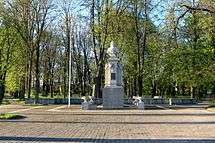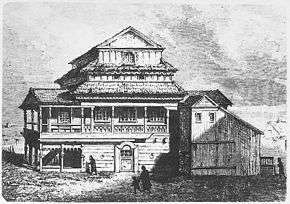Jurbarkas
| Jurbarkas | |||
|---|---|---|---|
| City | |||
|
| |||
| |||
 Jurbarkas Location of Jurbarkas | |||
| Coordinates: 55°5′N 22°46′E / 55.083°N 22.767°ECoordinates: 55°5′N 22°46′E / 55.083°N 22.767°E | |||
| Country |
| ||
| Ethnographic region | Samogitia | ||
| County | Tauragė County | ||
| Municipality | Jurbarkas district municipality | ||
| Eldership | Jurbarkas city eldership | ||
| Capital of |
Jurbarkas district municipality Jurbarkas city eldership | ||
| First mentioned | 1258 | ||
| Granted city rights | 1611 | ||
| Population (2010) | |||
| • Total | 12,972 | ||
| Time zone | EET (UTC+2) | ||
| • Summer (DST) | EEST (UTC+3) | ||
Jurbarkas (![]() pronunciation ; Polish: Jurbork, known also by several alternative names) is a city in Tauragė County, Lithuania. It is on the right-hand shore of the Neman River at its confluence with the tributaries Mituva and Imsre. The town became an important road junction after a bridge was built over the Nemunas River in 1978.
pronunciation ; Polish: Jurbork, known also by several alternative names) is a city in Tauragė County, Lithuania. It is on the right-hand shore of the Neman River at its confluence with the tributaries Mituva and Imsre. The town became an important road junction after a bridge was built over the Nemunas River in 1978.
Etymology
The name Jurbarkas is derived from the Ordensburg castle, Georgenburg, built in the 13th century.
Jurbarkas has also been known by many derivate spellings in various languages throughout its history. The most notable non-Lithuanian names for the city include: in German, Georgenburg, Jurgenburg, and Eurburg, in Polish, Jurbork, and in Yiddish, יורבורג, Jurborg, Jurburg, Yurburg, Yurberig, and Yurbrik.
History


Although Jurbarkas is said to have been a seat of Lithuanian princes from the Palemonids legend, it was first documented in 1259 as the Teutonic Knights' Ordensburg castle of Georgenburg ("George's castle") on the Neman. This castle was constructed 3 km (1.9 mi) west of the current town on a hill now known as Bispiliukai, while the Lithuanians built a castle on Bispulis hill by the Imsre. Although the German crusaders were often at war with the Lithuanians, Mindaugas, King of Lithuania, did not oppose Georgenburg's construction after his conversion to Christianity.
The castle of Georgenburg was abandoned by the Teutonic Knights after their defeat in the Battle of Grunwald in 1410. The region was included within Lithuania in the Treaty of Melno in 1422, and the current site of Jurbarkas began to develop as a border town and customs point, growing through the exporting of lumber on the Neman to Ducal Prussia. In 1586 famous chronicler Maciej Stryjkowski became a church provost in Jurbarkas. King Sigismund III Vasa granted Jurbarkas its Magdeburg rights in 1611.
In 1795 Jurbarkas was annexed by the Russian Empire during the third partition of the Polish–Lithuanian Commonwealth and was part of Vilna Governorate, later a part of Kovno Governorate (1843–1915). Its growth stagnated during the 19th century as traffic on the Nemunas decreased because of the rise of railways. The town was briefly liberated from the occupying Russian forces by the insurgents during the November Uprising in 1831. Because of its riverside location, Jubarkas often suffered from floods (notably in 1862). 120 houses burned down from a fire in 1906.
The Jewish community

Jurbarkas was for centuries a multi-ethnic community. During the 17th century some of the town's Jewish population were employed as tax collectors for the Lithuanian government. By 1714 Jubarkas had 2,333 Jews. By 1790 the town had a Jewish cemetery and a Wooden synagogue, one of the oldest in the region. In 1862 there were 2,550 Jews. In 1843 Emperor Nicholas I ordered that Jews living within 50 km (31 mi) of the Empire's western border should relocate eastward, but Jurbarkas was one of 19 towns which disobeyed the order. The Jewish Enlightenment (Haskalah) prospered in Jurbarkas.
Many of the town's citizens left during World War I, although some returned. It became part of Raseiniai County in the independent Lithuania created after the war. The population decreased from 7,391 in 1897 to 4,409 in 1923. The Jewish population decreased over the same period from 2,350 to 1,887, though that represented an increase from 32% to 43%. A government census in Jurbarkas in 1931 indicated that Jews owned 69 of 75 business and 18 of 19 light industries. While Jurbarkas had been for generations a town of tolerance, during the nationalist climate of the 1930s Jews suffered from persecution such as suppression of their commerce, physical attacks, and burning of their property.[1]
The Soviet Union occupied the town in 1940 during World War II and nationalized many of the Jewish-owned companies. Jewish cultural organizations were also suppressed. Jurbarkas was invaded by Nazi Germany on 22 June 1941, the first day of Operation Barbarossa. Among other persecutions, Lithuanian collaborators forced the Jews to destroy the wooden synagogue.[2] The Jewish population of Jurbarkas was systematically killed in 1941.[2] A few dozen Jews from the town and escapees from the Kaunas Ghetto formed a partisan group to attack Nazi forces, although the majority were killed. A monument at the mass graves was constructed after the war to honor the Holocaust victims.
Few of Yurburg’s Jewish citizens survived World War II. Of those that did, some remained in Vilnius or Kaunas after the War, while most emigrated to Palestine, the US, Canada, Mexico, South Africa, Germany, or other nations – in some cases joining family and friends who had left Lithuania before the War.[3]

Former residents, their descendants, and scholars have chronicled Jewish life in Yurburg before, during, and after the War through memoirs, biographies, websites and a memorial. The Memorial Book of the Jewish Community of Yurburg, Lithuania was published in Hebrew in 1991 (Zevulun Poran, Editor), and was updated and translated into English in 2003 (Joel Alpert, Editor). More information on the Jewish community of Yurburg is available.
The recently (2005) completed Memorial to the Murdered Jews of Europe in Berlin commemorates the Krelitz Family of Yurburg in the ‘Family Fates’ room of the Memorial’s Information Center located under the Memorial.
The Jewish cemetery at Yurburg stands as a lone sentinel of its once thriving and vibrant community, and one of the best preserved in a small town of Lithuania. Over 300 headstones, some dating as early as the 1700s, are visible. In recent years, volunteers and government officials have made significant strides to repair, maintain and archive the headstones at the cemetery. Restoration and maintenance work at the cemetery is ongoing, and represents collaborative efforts by numerous volunteer and government organizations and individuals, including former Yurburg residents, their descendants around the world (via the US-based “Friends of the Yurburg Jewish Cemetery”), Jewish and non-Jewish individuals and groups from both inside and outside Lithuania (including the Kaunas Jewish Community Center) - as well as by dedicated local officials and residents from present-day Jurbarkas.
In 2006 United States Commission for the Preservation of America's Heritage Abroad designated the Jewish Cemetery of Yurburg as one of its official projects.
In 2007, significant restorative work was conducted at the site by volunteers from Dartmouth College, together with volunteer students from the A. Giedraitis-Giedrius Gymnasium of Jurbarkas. A catalog of the headstones and the translated names has been placed on the web.
Jurbarkas resident and volunteer Rita Vaiva has been painstakingly re-inscribing lettering on headstones at the Yurburg Jewish Cemetery.
Famous residents
- Vincas Grybas (1890–1941), sculptor
- Romualdas Marcinkus (1907–1944), Footballer, and Pilot during World War II
- Maciej Stryjkowski (ca. 1547 – ca. 1593), Polish-Lithuanian historian, writer and poet
- William Zorach (1887–1966), Jewish sculptor
Partnership
References
- ↑ Dov Levin and Josef Rosin, edited by Sarah and Mordehai Kopfstein."Yurburg (Jurbarkas), section 1". Hebrew University of Jerusalem. Accessed July 8, 2008.
- 1 2 Dov Levin and Josef Rosin, edited by Sarah and Mordehai Kopfstein."Yurburg (Jurbarkas), section 2". Hebrew University of Jerusalem. Accessed June 22, 2006.
- ↑ http://www2.jewishgen.org/yizkor/jurbarkas/yur475.html The House of Yurburg in Jerusalem
- Joel Alpert. The Memorial Book for the Jewish Community of Yurburg, Lithuania - Translation and Update. Lightning Source UK Ltd, ISBN 0-9741262-0-9)
External links
| Wikimedia Commons has media related to Jurbarkas. |
- Jurbarkas regional council
- Jurbarkas information
- History of Yurburg (Jurbarkas)
- Photos of Yurburg
- Jurbarkas Area History Museum
- The Memorial Book for the Jewish Community of Yurburg, Lithuania
- The murder of the Jews of Jurbarkas during World War II, at Yad Vashem website.


